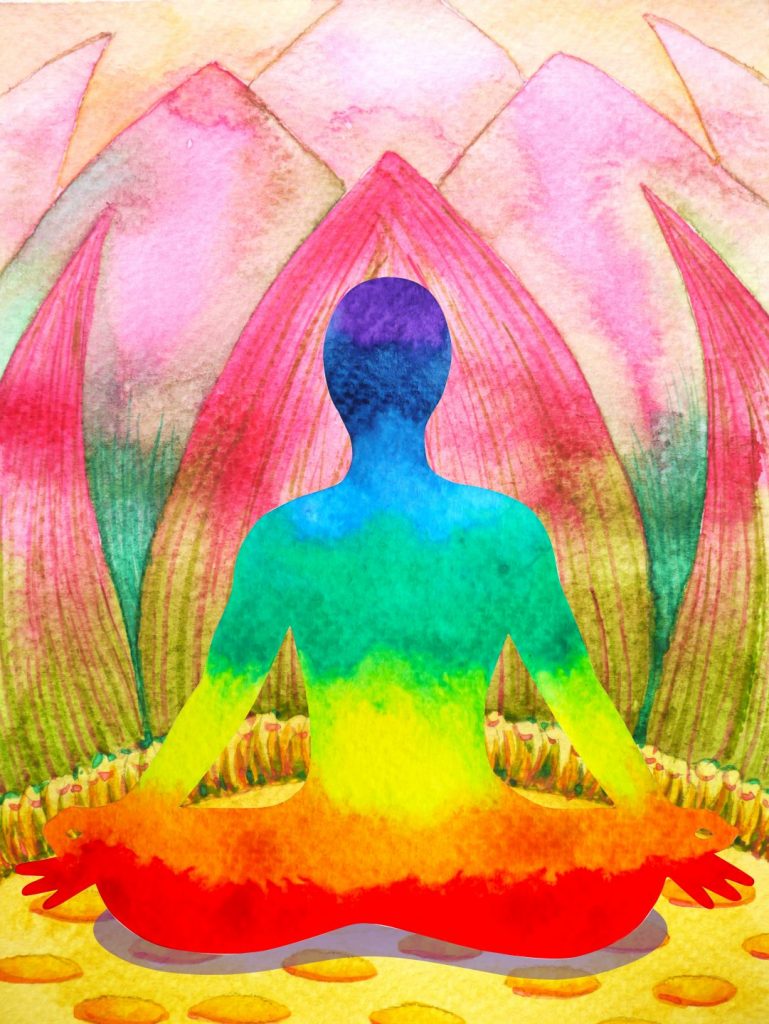Healing with Color
Color has been used as a healing tool for centuries. Our eyes open every day to see an ever-changing spectrum of light and color. Color, in the form of energy, also permeates through the aura, a luminous body that surrounds a physical one. Each aura layer is represented by a color and surrounds the body in a net of energy. As humans, we respond to the energy of color and it is so powerful that someone color blind or visually impaired can feel it.
Auras and Chakras
Like auras, chakras also come with specific, spiritual colors. Derived from the Sanskrit language, a chakra is a pool of energy inside the body. There are seven chakras that connect to major organs. Each chakra distributes energy throughout the body and although most people have heard of seven chakras, there are a total of 114 in the body. While aura spiritual colors change with mood and intent, the chakra spiritual colors are deeply anchored and stay constant.
Auras can reveal diseases and lack of health, or they can balance in an individual. An aura can disclose a present mental, physical, and spiritual state. However, both aura and chakras are vital to an individual’s health and well being. These channels of energy can get obstructed due to stress or illness, and impact overall health. Certain forms of meditation, Reiki, Tai Chi and other sciences from across the world help relieve blocked chakras and purify auras to restore health and well being.
Color Therapy
Color therapy has also been found to be useful in stress-related disorders such as eczema and mild depression. It is particularly valuable when it is used alongside other therapies practiced in conventional medicine. Color therapy is an ancient concept believed to have started with the Egyptians. With the help of the sun’s rays, colorful gems were used to intercept the sunlight into those who sought healing. Such treatments were aimed to restore balance to emotional, spiritual, or physical levels. While scientifically unproven, studies demonstrate color affects mood and can have measurable effects on the emotional and physical behavior. A color therapist uses a variety of techniques to diagnose illness and identifies a lack of one or more colors within the body.
In a healthy human, all the colors of the spectrum are visible in the aura with red nearest to the body and extends outward. The same holds true for chakras. The energy centers within the body are closely linked to the function of internal organs and systems, and each have a corresponding color. A color therapist seeks to harmonize the imbalances within the aura or chakra by identifying which colors are missing. While every color contains an energy vibration, the body’s exposure to an appropriate color can correct or enhance the body’s energy flow. Treatments for imbalances are corrected with exposure to color. Patient color treatments are derived with lamps, crystals, silk, food, or liquids.
Color is delivered in the form of light energy, and different colors affect the amount and type of light that falls upon us. Color enters through the eyes and skin which permeates the aura that triggers a chemical and hormonal change in the body that directly relates to health and well being. Exposure to specific color can adjust the intake of light energy to bring balance to the body.
Awareness of an individual’s spiritual colors can help produce a more balanced energy through the body which, in turn, can help maintain health, happiness and well being.
 Spiritual Colors
Spiritual Colors
#1 Root Chakra (Muladhara) – Red is the color of the root chakra, the energy center within the body that is associated with physical activity, emotional strength, and intimacy. When exposed to red, there is a measurable reaction in the body. Blood pressure, temperature, and energy levels increase, circulation improves, and breathing, pulse rate and brainwave action quicken. However, these reactions are only temporary effects and quickly die down when the color is withdrawn. The red aura relates to sexuality, competitive spirit, and vitality.
#2 Sacral Chakra (Svadisthana) – Orange, the color of the sacral chakra, promotes joy and the feeling of well being and correlates with the abdomen and adrenal glands. Often a favorite of children and talkative adults, orange is also a color chosen in tests by those suffering from mental or physical exhaustion, perhaps signifying a subconscious desire for a less stressful life. The orange aura provokes change, creates opportunity, and embraces enthusiasm and freedom.
#3 Solar Plexus Chakra (Manipura) – Yellow is a powerful eliminator that cleanses and tones the entire system. This physical benefit applies to emotional baggage, since holistic medicine believes that illness can be caused from the stress of unresolved situations that one has difficulty letting go. The yellow chakra is controlled by the liver and pancreas and promotes healthy digestion.
#4 Heart Chakra (Anahata) – Green represents the color of nature and brings harmony to all in its presence. As a general tonic and detoxifier, green balances the energies of the body, mind and spirit and relieves mental stress. Green depicts the energy center of the body where the heart and lungs are located. Often preferred by the civilized and conventional, green is rejected by the lonely or those with a degree of mental disturbance.
#5 Throat Chakra (Vishuddha) – Blue encourages relaxation and tranquility and is ideal for places of healing. Considered a cold hue, blue offers a cool effect that quiets the mind and soul. The blue chakra of the throat region represents the ability to verbalize. Blue is the top choice in color preference tests and tend to be chosen by conservative, accomplished, and successful people. However, it is often rejected by people who are anxious and cling to a sense of failure.
#6 Third Eye Chakra (Ajna) – Linked to the brow and crown chakra, the energy of indigo is closely linked to the third eye, which is known as the center for creative visualization. Indigo energy connects us to our unconscious self and gives the experience of being universal. With a link to the head, color therapists use indigo and violet to treat a range of mental disorders.
#7 Crown Chakra (Sahasrara) – the only chakra found outside the physical body is located just above the head and is considered the spiritual body. The crown chakra is associated with higher consciousness and a state of pure being. While there is no physical organs associated with the crown chakra, it vitalizes the upper brain, and the color is a light purple or indigo, or white.
Color is an intrinsic part of each of us. The influence of color impacts individuals, industry, and the environment. As we harness the power of color, we also envelop ourselves in the vibrations and tones to bring balance and harmony to our everyday lives.
Learn how color can change your world, your health, and your attitude at our upcoming International Summit this November 15th to 17th in Tucson AZ. Feel the stress melt away under the Arizona sun at the El Conquistador Tucson. Registration is open and hotel reservations can be made at a discounted rate while available.
Related Posts










